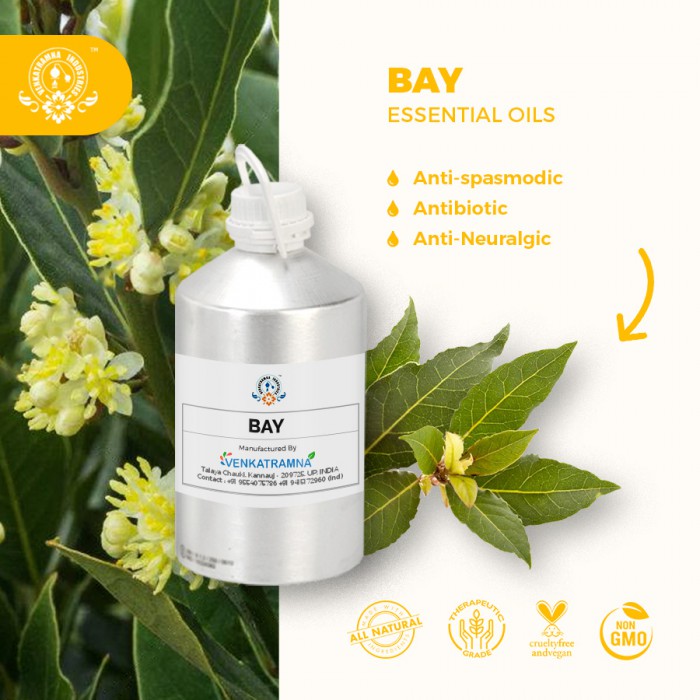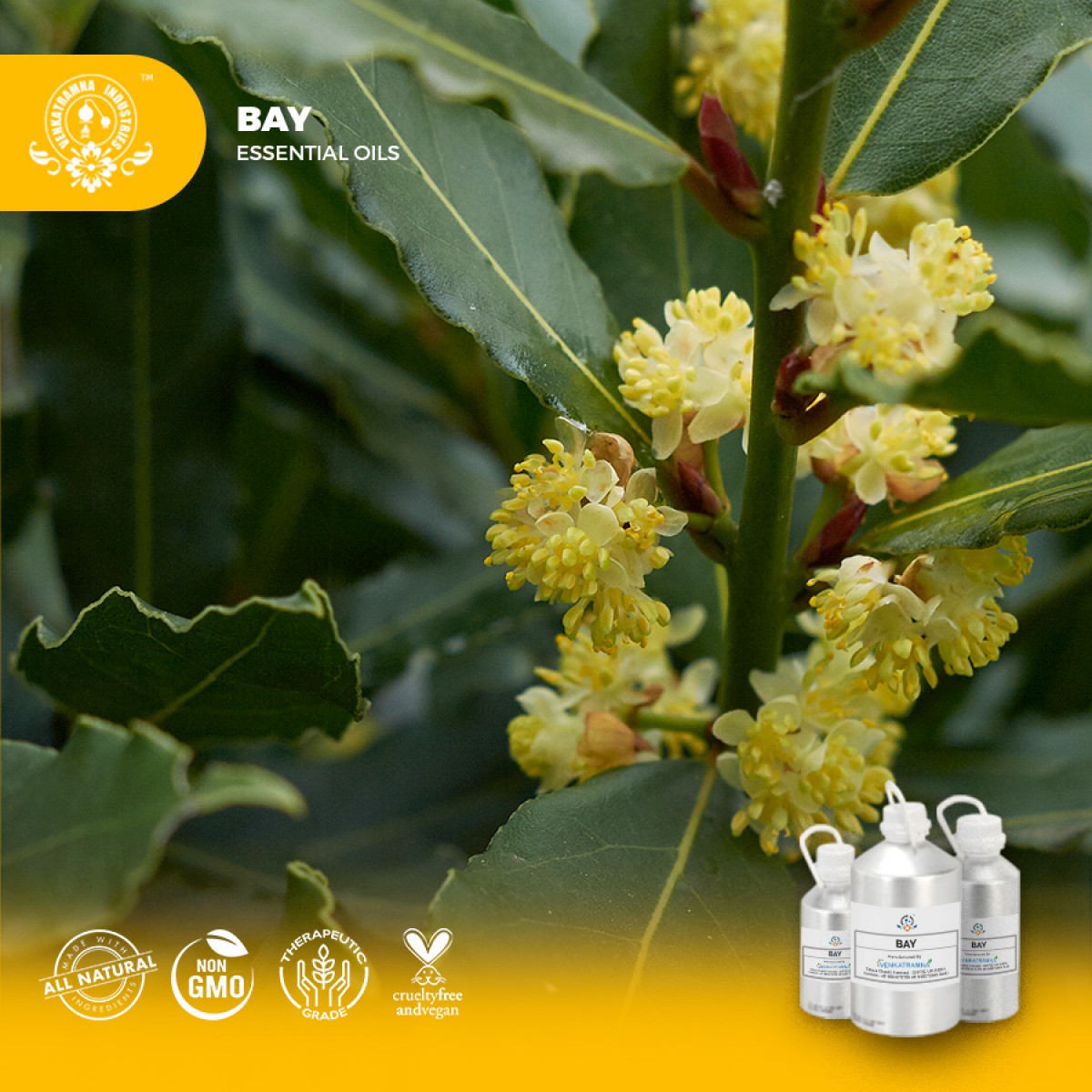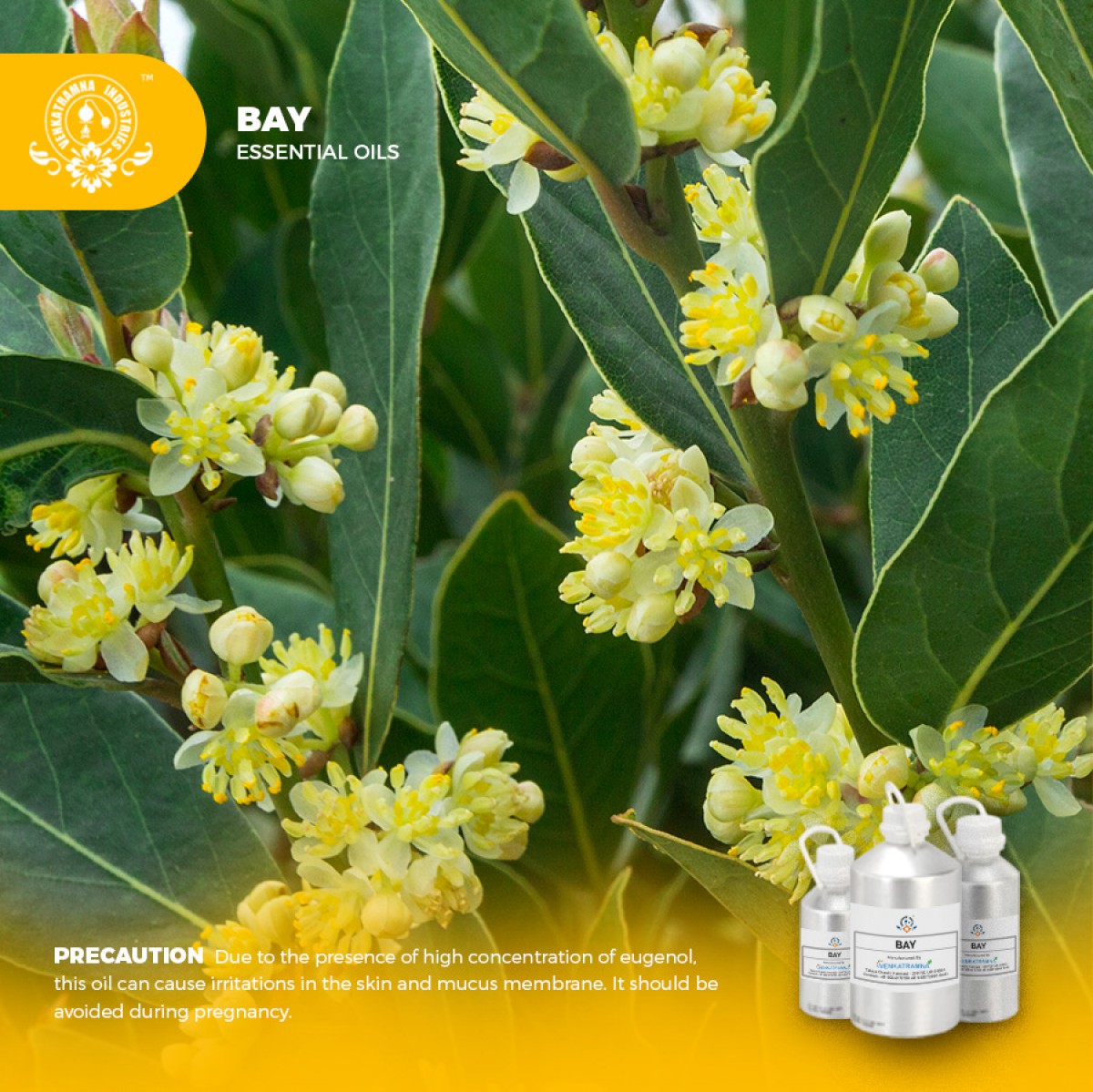Botanical Name: Laurus nobilis L. Common name: Bay leaf, bay laurel, sweet bay Read More
Botanical Name: |
Laurus nobilis L. |
|
Common name: |
Bay leaf, bay laurel, sweet bay |
|
Plant family: |
Lauraceae |
|
Genus: |
Laurus |
|
Appearance/Color: |
pale yellow green to orange brown
liquid with a thin consistency. |
|
Odor: |
Bay has a spicy bay leaf scent with a strong top
note. |
|
Blends With: |
Blend with Bergamot, Virginian, Cedarwood, Eucalyptus, Fennel, Ginger,
Orange, Patchouli, Rosemary, Ylang-Ylange. |
|
Origin |
Hungary |
The
bay tree is native to the Caribbean islands from where it is believed to have
spread to other parts of the world. Bay held an important place in Ancient Rome
and Greece as well, in their religion, culture, and in their medicines.
This
is extracted by steam distillation of fresh leaves of the bay tree, whose
scientific name is Laurus Nobilis.
However,
science we are here to discuss the medicinal importance of this essential oil,
we shall now see what treasures it holds for our health.
This
is an evergreen tree which can grow up to 20 meters high with dark green,
glossy leaves and black barriers. Bay was very popular with the Romans, who
thought it was a symbol of wisdom, peace and protection. The latin Laudis means
‘to praise’, which is why the victors at the Olympic games were presented with
a laurel wreath made of bay leaves.
Bay is widely cultivated as an ornamental plant in regions with Mediterranean oceanic climates, and as a house plant of greenhouse plant in colder regions. It is used in topiary to create single erect steam with ball-shaped, box-shaped or twisted crowns; also, for low hedges. Together with a gold from, L. nobilis ‘Aurea’.
The complete range of conditions or methods of use are beyond our control therefore we do not assume any responsibility and expressly disclaim any liability for any use of this product. Information contained herein is believed to be true and accurate however, all statements or suggestions are made without warranty, expressed or implied, regarding accuracy of the information, the hazards connected with the use of the material or the results to be obtained from the use thereof. Compliance with all applicable federal, state, and local laws and local regulations remains the responsibility of the user.
The FDA has not evaluated the statements on this website. No claims are made by Venkatramna Industries as to the medicinal value of any products from vriaroma.com or by us. The information presented here is for educating our customers about the traditional uses of essential oils and is not intended to diagnose, treat, cure, or prevent any disease. You are responsible for understanding the safe application of these products. If you have any questions, please call or email us for further information.
As per NAHA guidelines, New Directions Aromatics (NDA) does not recommend the ingestion of essential oils. It is imperative to consult a medical practitioner before using Essential Oils for therapeutic purposes. Pregnant and nursing women and those taking prescription drugs are especially advised not to use this product without the medical advice of a physician. The oil should always be stored in an area that is inaccessible to children, especially those under the age of 7.
Bay leaf has many traditional benefits
in culinary. Despite that is a common part of Indian spices (Hot spices) which
is used in cooking to improve flavor and taste of the food.
The
main constituents of bay essential oil are alpha pinene, alpha terpineol, beta
pinene, chavicol, geranyl acetate, eugenol, linalool, methyl chavicol, myrcene,
and neral.
The
health benefits of bay essential oil can be attribute to its properties as an
antiseptic, antibiotic, anti-neuralgic, anti-spasmodic, analgesic, aperitif,
astringent, cholagogue, emmenagogue, febrifuge, insecticide, sedative,
stomachic, sudorific, and tonic substance.
Its
exotic aroma has relieving effects on mind. It is used
as spice in Indian foods to add flavoring and taste while cooking.
·
Antiseptic
·
Antibiotic
·
Anti-Neuralgic
·
Anti-Spasmodic
·
Analgesic
·
Aperitif
·
Astringent
·
Cholagogue
·
Emenagogue
·
Febrifuge
·
Insecticide
·
Sedative
·
Stomachic
·
Sudorific
·
Tonic
|
S.No |
Key Constituents |
Strength (%) |
|
1 |
1,8-Cineole |
38.1-43.5% |
|
2 |
a-Pinene |
7.1-15.9% |
|
3 |
a-Terpinyl acetate |
4.5-7.0% |
|
4 |
Linalool |
6.2-6.5% |
|
5 |
b-Pinene |
4.9-6.5% |
|
6 |
Sabinene |
4.5-6.5% |
|
7 |
Methyl eugenol |
1.4-3.8% |
|
8 |
Eugenol |
1.2-3.0% |
|
9 |
Camphene |
0.7-2.9% |
|
10 |
Linalyl acetate |
0.4-2.7% |
|
11 |
Bornyl acetate |
0.4-2.3% |
|
12 |
Terpinen-4-ol |
2.1-2.2% |
|
13 |
a-Terpineol |
0.9-1.9% |
|
14 |
b-Myrcene |
0.7-1.5% |
|
15 |
Borneol |
0.1-1.5% |
|
16 |
b-Caryophyllene |
0.1-1.5% |
|
17 |
Terpinolene |
0.1-1.1% |
|
18 |
g-Terpinene |
0-1.0% |
Safety Summary
·
Hazards: Potentially carcinogenic, based on methyl
eugenol content; essential oils high in 1,8-cineole can cause CNS and breathing
problems in young children; skin sensitization (low risk); mucous membrane
irritation (low risk).
·
Cautions (dermal): Hypersensitive, diseased or damaged skin,
children under 2 years of age. Some laurel leaf oils may cause skin
sensitization.
·
Maximum adult daily oral dose 18 mg
·
Maximum dermal use level
|
EU |
0.005% |
|
IFRA |
0.01% |
|
Tisser and and young |
0.5% |
Safety advice
Recommended dermal maximum of 0.5% and on oral maximum of 18 mg, based on 3.8%
methyl eugenol content with dermal and oral limits of 0.02% and 0.01% mg/kg.
Organ-specific
effects
· Adverse skin reactions: In a 48-hour occlusive patch test on 50
Italian volunteers, undiluted Bay leaf oil produced on adverse reactions.
Similarly tested at 1%, it produced no reactions in 380 eczema patients.
Undiluted Bay leaf oil was moderately irritating to rabbits, but was not
irritating to mice or pigs. Tested at 2%on 25 volunteers it was not irritating,
nor was it irritating when re-tested at 10%. A second sample Bay leaf oil was
non-phototoxic in hairless mice and swine. Bay leaf absolute was phototoxic at
10% or over, but not at 2%.
Systemic effects
· Acute toxicity: Bay leaf oil
acute oral LD50 in rats 3.95 g/kg; acute dermal LD50 in rabbits>5 g/kg.
1,8-Cineole has been reported to cause serious poisoning in your children when
accidentally instilled into the nose.
· Antioxidant/pro-oxidant activity: A Bay leaf oil
showed moderate antioxidant activity in scavenging DPPH radicals and inhabiting
lipid peroxidation.
· Carcinogenic/anticarcinogenic
potential: Bay leaf oil containing 2.5% Methyl eugenol
was active against human melanoma, renal cell adenocarcinoma, and human chronic
myelogenous leukemia cell lines in vitro. Methyl eugenol is a rodent carcinogen
if exposure is sufficiently high.
·
Ecotoxicity: No data available.
·
Bioaccumulation: No data available
·
Mobility in soil: No data available
·
Persistence and degradability: No data available
·
PBT and vPvB assessment: No data available





 MSDS-Bay_Essential_Oil1.pdf
MSDS-Bay_Essential_Oil1.pdf




